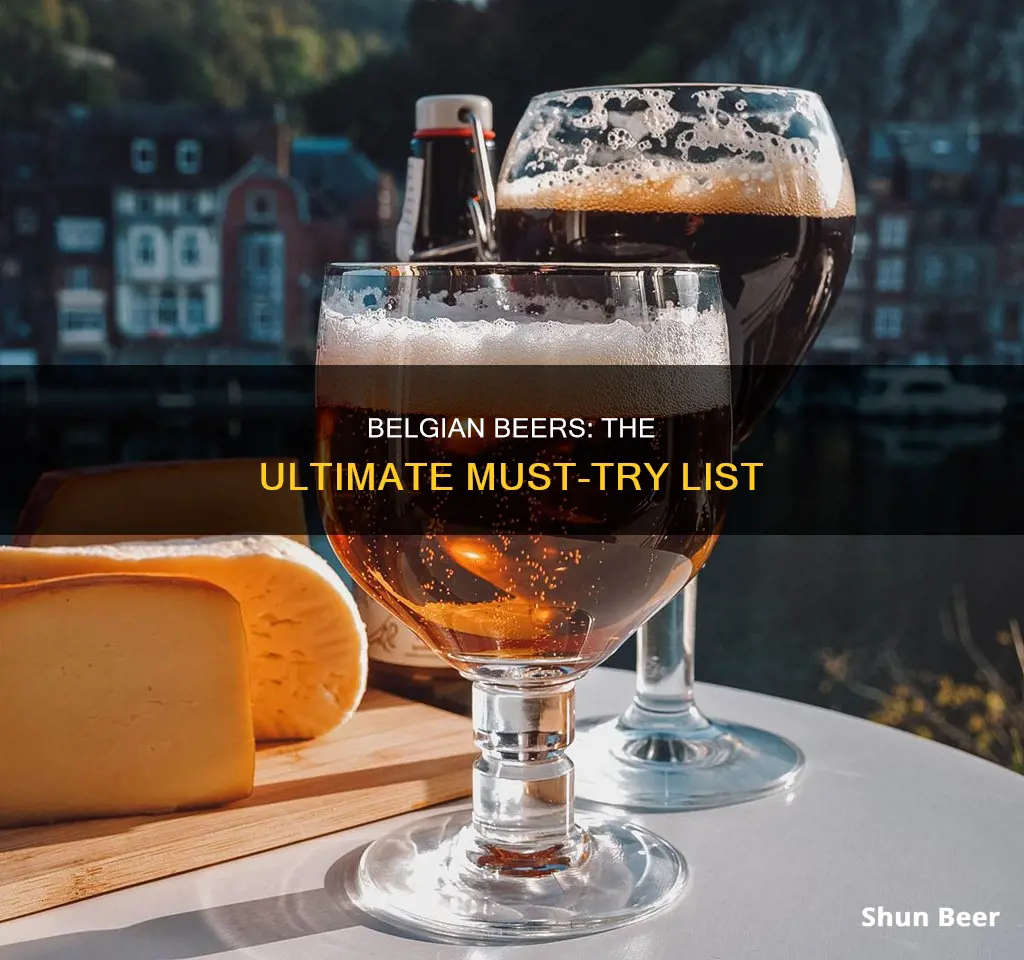
Belgium is known for its beer, and with good reason. With over 200 breweries and 700 beers in production, there's a lot to choose from. But where to start?
Belgian beer is diverse, with a wide range of flavours and styles. But there are some common threads. Belgian beer is known for its high alcohol content, with most beers clocking in at 7% ABV or more. It also tends to be bottle-conditioned, which means it's fermented in the bottle to create a fuller mouthfeel and a long-lasting head.
When it comes to specific beers, Trappist beers are a good place to start. These are beers brewed by Trappist monks, often inside monasteries, and are widely regarded as some of the best in the world. Examples include Orval, Westmalle, and Westvleteren, which is often ranked as the best beer in the world.
Other must-try Belgian beers include Delirium Tremens, a spicy amber ale from Ghent; Hoegaarden, a refreshing wheat beer; and Rodenbach, a tangy, reddish-brown ale.
And don't forget to pay attention to the glassware! In Belgium, each beer has its own specific glass, designed to showcase the beer's unique aromas and flavours. So sit back, relax, and sip your Belgian beer from the properly shaped glass—cheers!
| Characteristics | Values |
|---|---|
| Trappist Beers | Brewed by monks in monasteries |
| Lambic Beers | Spontaneously fermented in open air vats |
| ABV | 6% and above |
| Glassware | Wide opening, chalice-like glasses |
| Serving Temperature | Slightly below room temperature |

Trappist Beers
The Trappist brewing tradition began in Belgium when monks brought their beer recipes with them as they fled to the country in search of religious freedom. As the water in Belgium was unsafe to drink, beer was both safer and cheaper. This led to beer being drunk by adults and children alike.
There are strict rules surrounding what can be classified as a Trappist beer. The first is that the beer must be brewed inside a working monastery, by monks. Secondly, any profits made from the beer must be used within the monastery or donated to charity.
There are only 10 Trappist breweries in the world, with six of them in Belgium. They are:
- Achel
- Orval
- Scourmont-Lez-Chimay
- Rochefort
- Westmalle
- Westvleteren
Westvleteren is often considered the best beer in the world, but it is very hard to get your hands on. If you want to try it, you'll either need to order it two months in advance and pick it up from the monastery yourself, or head to The Monk bar near St. Catherine's Church in Brussels, where it is sometimes available off-menu.
Beer and Gallbladder: A Healthy Relationship?
You may want to see also

Lambic Beers
Some popular lambic beers include:
- Drie Fonteinen Gueuze
- Brasserie Cantillon Kriek and Framboise
- Geuzestekerij De Cam
- Brouwerij Boon Geuze Mariage Parfait
- Gueuzerie Tilquin à l'Ancienne
- Allagash Brewing Co. Coolship Resurgam
- Primitive Beer So Last Season: Montmorency Cherry
- Cascade Brewing Kriek
Gastric Patients and Beer: Is It Safe to Drink?
You may want to see also

Belgian Ales
Classic Belgian ales are produced by regional breweries across the country. Generally, most breweries will have a pale ale, a dark beer, and a stronger beer, like a Tripel. One of the most popular Belgian ales is the Tripel, which is deliciously creamy and aromatic.
Another popular Belgian ale is the Dubbel, which has double the alcohol percentage of a regular beer. Despite their dark colour, dubbels are actually the sweetest of the three main categories of beer in Belgium: Dubbel, Tripel and Quadrupel. Dubbels are characterised by their dark brown colour, which comes from caramelising Belgian candi sugar.
One of the most famous Belgian ales is the Orval Trappist Ale, which has been brewed since 1931 at the Abbaye Notre-Dame d'Orval. It is widely regarded as one of the best beers in the world.
Beer and Whiplash: What You Should Know
You may want to see also

Dubbel, Tripel and Quadrupel
When it comes to Belgian beer, the world-renowned brewing expertise of the Trappist monks is an excellent place to start. The beers made famous by these monastic brewers and their secular imitators include dubbels, tripels, and quadrupels.
Dubbel
The name "dubbel" means "double" in Dutch. The name comes from the beer's higher alcohol content, which is double that of a "single", a weaker beer brewed by monks for their own consumption. The dubbel was first brewed in 1856 at the Abbey of Westmalle near Antwerp. It was a strong beer (6% to 8.5% ABV), with a coffee colour and a toasty, nutty finish. Dubbels today are still dark and hazy, with a malty, caramel-like sweetness and only hints of hoppy intensity. The deep colour comes not from roasted malt but from something called candi sugar (originally, caramelised beet sugar), which imparts chocolatey, dark fruit, and burnt caramel qualities.
Tripel
Tripels are golden, slightly cloudy ales with a bubbly head. They are hoppier and higher in alcohol content than dubbels, sometimes exceeding 10% ABV. The real ingredient that has been doubled and trebled in these recipes is malt, but of different varieties and roasts. Tripels derive their colour from Pilsner malt. They are deceptively drinkable, with inviting flavours like spiciness, banana, fruit, and a subtle hit of alcohol.
Quadrupel
The quadrupel is a more recent, non-Belgian style that combines the hue and flavour profile of the dubbel with the kick of the tripel. Quads are amber, lighter in body, but more bready and peppery overall. They are very strong, with ABVs routinely above 10%. They fall into the category of Belgian Strong Dark Ales, with a maltier, spicy yeast profile.
Beer and Breastfeeding: Is It Safe to Drink?
You may want to see also

Sour Beers
There are two traditional types of sour beer: Lambic and Flemish sours. Lambic beers are brewed in the Pajottenland region of Belgium, southwest of Brussels. The brewing process involves leaving the boiled wort in a wide, shallow trough, exposing it to the air so that wild yeasts and bacteria can settle on the surface. The beer is then run into oak barrels for a long series of spontaneous fermentations. Lambic producers blend their barrels to achieve a house style. Un-fruited Lambics are pale in colour and offer notes of lemon peel, lime juice, hay and flowers. Fruit and sweeteners are often added to make the beer more approachable, although many serious Lambic brewers retain its sourness.
Flemish sour red-brown ales are made in Belgium's Flanders region. These beers are made by inoculating the wort with the various microflora found in large wooden barrels called foudres. The result is a beer with more vinous characteristics and a sharp, acetic bite, offering flavours of sour cherries, tart Pinot Noir, leather, lemon rind and currants.
- Oude Geuze by 3 Fonteinen
- Cuvée Saint-Gilloise by Cantillon
- Oude Geuze by Geuzestekerij De Cam
- Oude Gueuze à l'Ancienne by Gueuzerie Tilquin
- Rodenbach Grand Cru
- Duchesse de Bourgogne
- Mort Subite Oude Kriek
- Oude Kriek Cuvée Réne by Lindemans
- Gueuze 100% Lambic by Cantillon
- Black Label Geuze by Boon
- Oude Gueuze Tilquin
- Flemish sour red ale by Rodenbach
- Flemish sour red ale by Verhaeghe Vichte
- Flemish sour ale by Omer Vander Ghinste
Beer After Its Sell-By Date: Safe to Drink?
You may want to see also
Frequently asked questions
Belgium has a wide variety of beers, with over 200 breweries and 700 beers in production. Some of the best Belgian beers to try are:
- Orval Trappist Ale
- Blanche De Bruxelles Witbier
- Omer Traditional Blond Ale
- Brasserie de la Senne Taras Boulba
- Saison Dupont Farmhouse Ale
- Westmalle Trappist Dubbel
- Tripel Karmeliet Belgian Ale
- St. Bernardus Abt 12
- La Chouffe Golden Ale
- Gouden Carolus Classic
The three main categories of beer in Belgium are Dubbel, Tripel and Quadrupel, which differ in alcohol percentage and flavour. A Dubbel typically has an alcohol percentage of 6-9%, whereas a Tripel is usually around 7.5-10%. A Quadrupel is less restrictive and includes any beer with an alcohol percentage above 10%.
Trappist beers are brewed using traditional methods developed by monks. There are only 10 Trappist breweries in the world, 6 of which are in Belgium. Trappist beers must be brewed inside a working monastery by monks, and any profits must be used within the monastery or donated to charity.
Belgium has a specific way of serving and drinking beer, including a 9-step pouring process called The Belgian Pouring Ritual. Belgian beers are typically served with a solid 2 inches of foam on top, and are best served slightly below room temperature.







